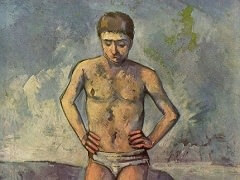Rocks at Fountainebleau, 1898 by Paul Cezanne

In Cezanne's earlier painting, a barrier in the foreground implied a detached position from which the painter might contemplete a quiet view. In Rocks at Fountainebleau, 1898, the landscape is formed mainly by the obstructing ground, which is pathless and convulsed - a space with deep clefts and hollows in a dark purple haze. The obstacles force us to stand still, but we cannot look serenely; they impose their violence and restlessness upon us. This cavern space is the vision of a hermit in despair.
In this somber, passionate painting, so saturated by the catastrophic mood, there is a remarkable inner development - a course of feeling moving upward and into depth. The powerful rocks in the lowest part have a strange organic quality - a visceral effect - in their curved and congested forms. We discern a vague human profile in the lower right and physiognomic intimations - a reclining head - in the brighter central rock with scalloped edge. Beyond at the left, the monstrous ground coils and twists into depth. In this tumultuous play of dimmed purple masses, the spectrum of Cezanne's marvellous palette enriches the monochrome surface with a transparent layer of deepened tones. Beneath the common purple is revealed the underground of feeling it has overcast, and out of these changing chords rises the unique orange and yellow lighting of the central rock.
From this region of crowded, pulsing forms, we pass to a higher barrier of angular rocks, one, especially, impending and architectural in form, sharp-edged like a block of cut stone; it slopes forward and to the left, in opposition to the lower rocks. From their hidden depths rise the tree trunks in tilted lines, parallel to the edges of the rocks; they carry a vaporous foliage, spotted like the rocky surfaces below, and crossed by the nerve-like branches which repeat the contours of the rocks in a disengaged line. The fourth region - the sky - is an immaterial void, pale, remote, and sunless, with a fantastic, spreading silhouette. The rare line of the horizon, marking the observer's point of view, is soon lost among the trees and rocks.
There is a similar landscape in the writing of Flaubert, who, like Cezanne, knew the alternatives of contemplation and despair, and bound himself in art to an exacting discipline of reality and the word. In his great novel, The Sentimental Education, he describes the same forest of Fontainebleau as the setting of two lovers who have left Paris for the peace of nature during the convulsions of 1848. "The path zigzags between the stunted pines under the rocks with angular profiles; this whole corner of the forest is somewhat stifling, a little wild and close . . . One thinks of hermits . . . Rosanette stumbled, she was in despair and wanted to cry..."














